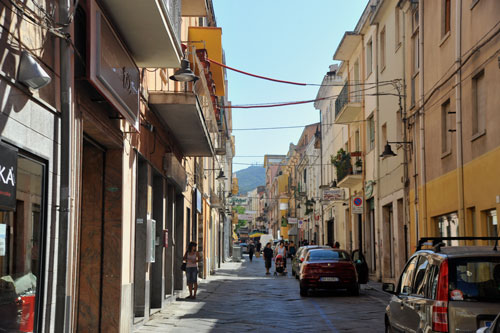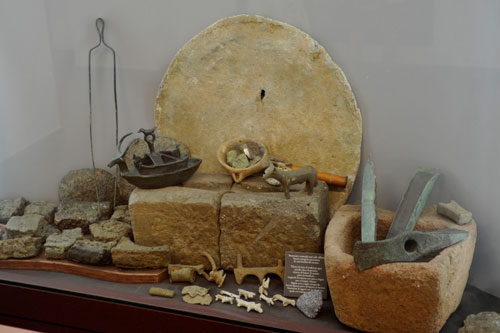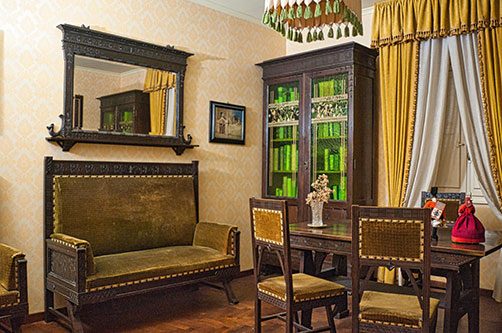Nuoro
to the map with the marked sights
 The capital of the province of the same name is located in the middle of Barbagia on a high plateau. No matter from which direction you approach the town – modern buildings dominate the picture.
The capital of the province of the same name is located in the middle of Barbagia on a high plateau. No matter from which direction you approach the town – modern buildings dominate the picture.
The history of the town can be traced back to the 12th century. In the 19th century, the town was granted the town status. Its most turbulent development occurred after 1927, when Nuoro became the capital of the province.
In the 1950s and 60s, there were repeatedly large-scale bandit hunts launched from here into the mountains.
Today the town has about 37,000 inhabitants.
One of the most important folklore-festivals of Sardinia – the Festa del Redentore – takes place here at the end of August.
If you are interested in the traditions and costumes of the island, you should especially watch the annual parades which take place in Nuoro.
 Despite all the modernity, Nuoro has a stylish historic centre, where more and more side streets are being elaborately restored.
Despite all the modernity, Nuoro has a stylish historic centre, where more and more side streets are being elaborately restored.
Corso Garibaldi is the central shopping streetl of the town, but there also are nice shops, bars and boutiques alongside.
The habitants stroll along the Corso in the evenings.
Nuoro’s cathedral is in the immediate vicinity of the Corso as well as the birthplace of Grazia Deledda, probably the most famous Sardinian author, who won the Nobel Prize in Literature.
Today, this house is home to the “Museo Deleddiano“, which provides an interesting insight into the way of life of Sardinian citizens around 1900.
 The “Museo Archeologico” is a somewhat hidden near the cathedral.
The “Museo Archeologico” is a somewhat hidden near the cathedral.
Fossil remains of animals, which once had lived in Sardinia and an extensive collection of finds of the Nuraghic age are exhibited in this museum.
Tools, weapons and cult objects made of bronze visualize the former highly developed sheperd’s culture of that time.
In the back of the meseum, there is a reconstructed well temple. Trade goods and depictions of the shipping routes show Sardinia as part of the Mediterranean cultures, carrying on maritime trade.
www.musei.sardegna.beniculturali.it/musei/museo-archeologico-nazionale-g-asproni-di-nuoro/
 Outside the town centre, there is the “Museo della Vita e delle Tradizioni Popolari Sardi“.
Outside the town centre, there is the “Museo della Vita e delle Tradizioni Popolari Sardi“.
On signposts in Nuoro it is signposted as “Museo dei Costumi”.
This folk art museum displays a large collection of Sardinian art and craft products such as carpets, furniture, weapons and products of the Sardinian art of bread making.
The highlight of the exhibition, however, are the precious, mostly historical traditional costumes from all regions of Sardinia.
These often colourful garments, decorated with elaborate embroidery, are not all shown at the same time, but are regularly exchanged in the showcases, as they shouldn’t be exposed to light and other harmful influences for too long.
 The museum consists of several buildings, which reflect some typical Sardinian architectural styles.
The museum consists of several buildings, which reflect some typical Sardinian architectural styles.
One of the buildings is home to dolls with the famous carnival masks of Barbagia’s central villages.
Historical photos and explanations on panels give an overview of the history of the ancient carnival customs.
However, not all the buildings are open to the public. According to the friendly guard, an extension of the exhibition has been planned for years, but a concrete time frame has not been defined up to now.
Museo Deleddiano
 Museo Deleddiano is located in the birthplace of Grazia Deledda on the street named after her (see map).
Museo Deleddiano is located in the birthplace of Grazia Deledda on the street named after her (see map).
Grazia Deledda came from a wealthy family and began writing stories and poems at the age of 15, which were published in newspapers.
In 1899, Grazia Deledda moved to Cagliari, where she met her husband.
The wedding took place on January 11, 1900, and later that year, the couple moved to Rome.
Deledda had two sons and continued her literary work in Rome.
Her novels were translated into other languages, making her internationally renowned.

Starting in 1909, her works were illustrated by Giuseppe Biasi, a Sardinian painter and illustrator who also decorated the hall of the train station in Tempio Pausania with his folkloric oil paintings.
Her novels vividly depict the harsh life in Sardinia, earning her the Nobel Prize for Literature in 1926.
She was the second woman and the first Italian to receive this award.
Grazia Deledda died in Rome in 1936, where she was also buried.
In 1959, her remains were transferred to Nuoro at the family’s request and interred in a small chapel on Monte Ortobene.

In 1983, the Museo Deleddiano opened in her birthplace. The exhibition owes much to the generosity of her descendants, who provided numerous documents, photographs, and personal items.
Several rooms are designed according to descriptions from Deledda’s autobiographical novel “Cosima” – the kitchen, the pantry, and her youth bedroom.
The original furniture from her study in Rome was also brought here and the room was recreated for the exhibition.
Monte Ortobene
 Nuoro’s local mountain is definitely worth a visit, especially as you can drive right up to the summit by car.
Nuoro’s local mountain is definitely worth a visit, especially as you can drive right up to the summit by car.
If you have travelled by bus or train, you can also take the public bus.
A fully developed asphalt road winds up with many serpentines through the forest. You also pass some springs.
At the summit you will find bars and restaurants, nice shady picnic areas and souvenir stands.
The “Statue of the Redentore”, to which a long pilgrimage takes place during the “Festa del Redentore”, also attracts many visitors.
On the way to the top, you pass a viewpoint that offers a fantastic view of the surrounding valleys, the Supramonte massif and the village of Oliena in front of it. (photo)
Sas Concas Necropolis

The site consists of 20 rock-cut tombs (domus de janas) carved into the trachyte.
It dates back to around 2700 BC and is considered by some archaeologists to be the oldest and largest necropolis in the Barbagia region.
The individual tombs are partly composed of multiple interconnected chambers and have quite complex structures with anterooms, corridors, and side cells.
The necropolis can be freely visited.
If you are interested in exploring the interiors of the individual chambers, it is best to bring a flashlight.

A special feature here are the petroglyphs carved into the rock, depicting stylized, upside-down human figures.
How to get there: Leave the SS131 at the “Macomer, Oniferi” exit and head a short distance towards Oniferi.
The necropolis is located just a few meters from the SS128 on a small hillside and is easily visible from the road (see map).
Next to the small gate, there is a brown sign pointing to the site.
There are no proper parking spaces here, but next to the entrance, the guardrail is interrupted for a few meters, allowing you to park your vehicle on the roadside.
Nuraghe Ola

The area around Oniferi is rich in prehistoric sites, although some are quite hidden.
From the Sas Concas necropolis, a short detour north to the Nuraghe Ola is recommended, as it is easily accessible.
The Nuraghe is completely built from granite blocks, is very well preserved inside, and still stands about 10 meters high today. Inside, there is a large chamber with a tholos roof and niches; immediately to the left after the entrance, a staircase leads upwards.
The Nuraghe can be freely visited.
How to get there: Drive north from Sas Concas under the SS131. The Nuraghe is located about 1 km after the underpass on the left side and is easily visible from the road (see map).
